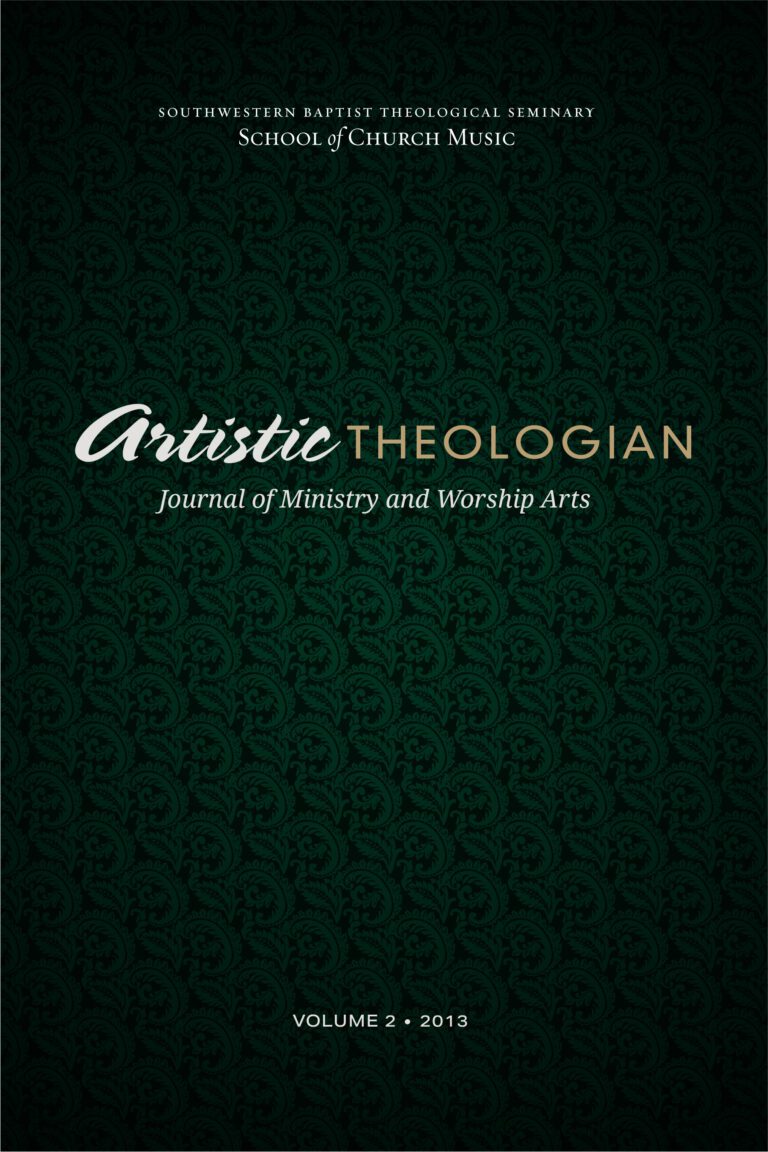
Worship Ministry: An Intersection of Ideas
Artistic Theologian
Volume 2, Summer 2013
Editor-in-Chief: John E. Simons
Personal Jesus: How Popular Music Shapes Our Souls, by Clive Marsh and Vaughan S. Roberts. Grand Rapids, MI: Baker Academic, 2012. 234 pp. $22.99.
Popular music is more than just a form of entertainment. In their book, Personal Jesus, Clive Marsh and Vaughan Roberts, both British scholars in the fields of theology and culture, seek to explore the cultural significance of popular music. “Ensuring the critical study of religion in relation to how people listen to contemporary popular music will foster appropriate understanding of the music itself. It will help us understand how religions do (and must) work in society today” (xv). It is this interplay between popular music and religion that is explored, examined, and evaluated in the three sections of this book.
Music and Religion seeks to explore the contemporary relationship of religion and popular culture. The authors then introduce the Magisteria-Ibiza Spectrum as a tool for comparing the influences of religion and popular culture on an individual’s affective space. “In the everyday world, and in the everyday life of listeners of music, whether those listeners be religious or not, it is the affective space they inhabit in their listening where their explorations of such issues and questions are in part being worked out” (27). Having examined the outside influences through the Magisteria–Ibiza Spectrum, the attention shifts to the role of popular music in the writings of contemporary theologians David Brown, Tom Beaudoin, and James K. A. Smith.
Living by Pop Music is an examination, largely using case studies of popular music songs, of popular music in contemporary society. Popular music has become a commodity: that which is bought and sold. “Religion and spirituality have themselves become consumer items” (43). This consumer culture is reflected in the church and the church’s music. “Some manifestations, such as the megachurch and the rise of praise and worship music, seem to be in direct response to (and even as a reflection of) consumer culture” (53). Since both religion and popular music are intertwined in this consumer culture, it further can be stated “commerce, faith, and pop are not discrete and disconnected elements in Western culture” (54).
Pop music and religion are linked not only through commerce but also through the body, transcendence, and the canon of song. Pop Music and the Body examines “how the visceral body, language, and social institutions interact in the specific areas of music and faith” (75). Tangentially related to the body, The Tingle Factor explores transcendent ecstasy, revealing that “music ‘was the most frequently mentioned trigger among the arts’ for evoking such experiences” (78). The “tingle factor” plays an important role in both pop music and religion. “The tingle factor puts us in touch with that which we cannot quite identify, but which is vitally important for human life, and which is very much the subject of theology” (89). Just as the Bible is a canon that speaks to a wide range of emotions, each person has a playlist representative of their life that speaks to an equally wide range of emotion. Though it may be easy for a song to enter one’s playlist, it is the music that stays on the playlist that shapes who we are. “In a clear sense, we are our playlists” (111).
The final section, Pop Music and Theology, brings together the roles of popular music and religion. Although the authors stop shy of calling music a religious experience, they do suggest it is a spiritual experience. From this posture, they suggest, “Many listeners may not be actively expecting their music practices to be a form of ‘edutainment’ (being educated while being entertained, or entertained while being educated)” (183). This failure to actively realize the role music is playing does not prevent it from shaping us, but allows us to be shaped without exerting control over that shaping. It is in this area that more work must be done not only in institutions but in the local church as well.
The cover and title of the book are misleading. Upon first encounter, it would appear that this book is a popular level treatment of the interplay between religion and popular music. Looks however are very deceiving. In actuality, this book is only understood by the scholar, and even the scholar in religion may need to seek external resources in culture to fully grasp the argument as it is presented.
Personal Jesus is a thoughtful, although highly technical, consideration of the role pop music and religion play in forming the individual. In building a strong argument, the authors often lose sight of intelligibility to the reader. Thankfully, the signposts used within the chapters allow the reader to reorient himself to the argument of the authors. The scholarship is outstanding, but even outstanding scholarship did not prevent this book from being a slow and frustrating reading experience.
Robert Pendergraft
Southwestern Baptist Theological Seminary
Fort Worth, TX





